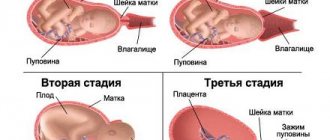When my water breaks - how long before I give birth? This question worries probably every woman who is soon expecting the birth of her long-awaited baby. However, no gynecologist can give an unambiguous answer to this question, since the process of labor is a purely individual process for each woman in labor. In order for everything to go well, you need to know what to do when amniotic fluid breaks, and when after this you should expect the first harbingers of the oncoming labor.
How to behave after the end of the OB?
What to do after the rupture of amniotic fluid? First of all, there is no need to panic - this is a physiological process that is one of the main precursors to childbirth. Now let's talk about what exactly needs to be done if the OBs move away.
If your water breaks, it's time to go to the hospital
- Remember, or better yet, write down in a notepad the exact time the OB is released. Then be sure to tell your gynecologist or nurse.
- Pay close attention to the color of the liquid. To prevent it from changing color, a week before giving birth, avoid dark underwear and bed linen - such actions will help you accurately determine the color of the OB.
- What should the broken water be like? Normally, they should not have any tint, that is, be completely transparent. If you notice an admixture of white flakes in the amniotic fluid, do not worry, this is normal.
- The greenish color of the OB indicates that literally in 6 hours the patient will give birth to the long-awaited baby.
- The amount of amniotic fluid is another important factor. It can be used to determine after what period of time labor will begin. The waters can be “frontal”, the volume of which does not exceed 300 ml, and real amniotic fluid (1.5 - 2 liters).
Helpful advice.
If you don't know how to determine which waters have broken, you can practice a little before your due date. You can do this as follows: pour a glass of water on the inner thigh. Remember your feelings, then pour one and a half to two liters of liquid onto the same part of the body. By doing this for at least a week, you will soon learn to distinguish between “front” waters and amniotic fluid.
After the effusion of amniotic fluid, it is necessary to urgently call an ambulance, especially if there was a lot of water. With a small number of them, you have a couple of hours left, but you should go to the hospital as soon as possible.
Important! We recommend reading important information about coronavirus during pregnancy:
Is the passage of the mucus plug a signal that labor is about to begin?
A mucus plug is a clot of mucus streaked with blood. It performs an important function - it protects the uterine cavity from infection. Thus, throughout the entire period of intrauterine development, the fetus is completely safe.
The passage of a mucus plug is not always a harbinger of impending labor. Many women mistakenly believe that it does not go away at all before the onset of labor.
The fact is that it can come off gradually, in veins, and not all at once in a lump. The process can begin long before the opening of the cervix and the passage of the ovary. For each pregnant woman, this depends on the characteristics of the body and the course of pregnancy.
Mucus plug during pregnancy
Important! If you notice frequent bloody or mucous discharge in your underwear, consult your doctor immediately. This may be evidence not of the removal of the protective plug, but of the addition of an infection. This condition requires immediate medical intervention!
What sensations occur when the plug comes out?
The passage of a mucous clot can be accompanied by quite unpleasant and painful sensations. However, it all depends on how acutely the expectant mother’s body reacts to pain.
For one woman, the process of removing the plug can be very painful and accompanied by discomfort in the lumbar region. For another mom, this may happen unnoticed, for example, while taking a bath, shower, swimming in the pool, or visiting the restroom.
After the mucus plug comes out, the cervix begins to gradually soften. The same thing happens with the birth canal. Due to this, the fetus can move freely along them, and with minimal risk to the mother’s health.
One of the most frequently asked questions about this is whether it is true that after the protective plug comes off, a baby appears immediately? And is it possible to speed up this process?
In this case, doctors give useful advice: do not try to speed up labor on your own - everything should happen gradually, and only naturally. Any intervention in the birth process can lead to life-threatening consequences for both the mother herself and her unborn baby.
To understand when labor begins after the plug is removed, you need to pay attention to some nuances:
- color and consistency of mucus;
- prolapse of the abdomen (if any);
- the presence of contractions, not false, but real;
- increased urge to defecate.
All these factors signal that you will meet your little miracle pretty soon, and you must be prepared for this moment.
Anhydrous period during childbirth: norm, maximum permissible, consequences
Amniotic fluid has a protective function: it protects the fetus from shocks and blows during the movement of the mother, as well as from the external aggressive environment. During childbirth, the waters are divided into anterior and posterior. The role of a hydraulic wedge that opens the uterine os is played by the anterior waters. The posterior ones are poured out simultaneously with the birth of the child’s body.
Eruption of water: normal
Based on the purpose of the amniotic membrane and anterior waters for the physiological course of labor, their preservation is important. Normally, effusion occurs after the cervix is completely opened. The amniotic sac bursts and the water flows out. Sometimes this does not happen, and then they are opened, because the bubble becomes flat and does not fulfill its function, but only gets in the way.
- If the waters break before labor begins, this condition is called prenatal rupture.
- If during labor, but not when the cervix is dilated, they speak of premature rupture.
Untimely rupture occurs in 12% of women in labor. Why is this happening? This is unknown. Some researchers have linked premature shedding to chlamydial infection.
There is a stage in childbirth when the baby is without water. This is a normal physiological phenomenon. If we determine the water-free period during childbirth by time, the norm is 6-12 hours during full-term pregnancy. They rarely wait longer than this time; usually after 6 hours they begin active actions.
What is the danger of premature rupture of water?
Why are people so afraid of a long waterless period? A person cannot be called sterile - many microorganisms live on the skin, in the vagina and in the internal environment. And many also have foci of chronic infection - untreated carious teeth, chronic tonsillitis, sinusitis, cystitis. In most cases, the flora is represented by cocci, rods, and fungi.
For an adult, such an infection is a natural flora with which the immune system is in a certain balance.
For a newborn who has not yet had contact with pathogens, any encounter can end in failure. The consequences of a waterless period during childbirth for the child include the threat of infection. Microbial infection threatens both the fetus and the mother. It causes chorioamnionitis (inflammation of the membranes) or endometritis (damage to the uterine wall).
Chorioamnionitis
Inflammation of the membranes of the fetus turns into an infectious lesion of amniotic fluid, which remains in some quantity, despite premature rupture. The causative agents of the disease are most often anaerobes, streptococci, staphylococci, enterococci, and there may be entire microbial associations. Sometimes infection occurs with a hidden clinical picture without clear symptoms.
Chorioamnionitis develops when the maximum permissible anhydrous period during childbirth is exceeded. Women are at risk after 24 hours from the moment of rupture of water.
Symptoms of the disease develop gradually:
- General malaise, weakness appear, the temperature rises, and the woman shudders.
- She has tachycardia, and according to CTG, the fetus also has tachycardia.
- Then purulent vaginal discharge appears.
- In a general blood test, all the signs of acute inflammation are an increase in the number of leukocytes, ESR, a shift in the leukocyte formula to the left.
- On palpation, unpleasant pain will appear in the uterine area.
In every fifth case, this disease develops into endometritis. To prevent progression of the disease, intensive treatment measures are necessary immediately after diagnosis of this condition:
- Antibiotics from the penicillin group and metronidazole, which act against anaerobic flora, must be prescribed.
- If the condition develops when the woman is already in labor, then attempts are made to stimulate the labor process with medication.
- If labor weakness develops, a decision is made to complete the birth by caesarean section. The operation is performed extraperitoneally to prevent infection of the peritoneum and the development of peritonitis.
Endometritis
Develops after a long anhydrous period against the background of chorioamnionitis. After a day or two, the condition worsens, worries:
- a sharp rise in temperature;
- intoxication;
- soreness of the uterus, it is increased in size;
- bloody discharge is profuse and does not decrease, accompanied by a foul odor;
- The uterus is characterized by subinvolution - it does not decrease in size and does not become denser.
Treatment is carried out with a course of antibiotics and detoxification treatment.
Obstetric tactics during the anhydrous period
The approach for full-term and premature pregnancies is different. If the pregnancy is 38 weeks or more, then a safe water-free period is considered to be 6 hours.
If labor has not developed during this time, then in order to avoid infectious complications, stimulation begins with the introduction of oxytocin drips under the control of fetal CTG.
A water-free period of 12 hours or more is extremely undesirable, especially if the woman’s smears showed an increased number of leukocytes and coccal flora.
In case of premature pregnancy, tactics depend on the period. If it exceeds 34 weeks, then a decision is made to perform vaginal delivery, unless there are contraindications for this from the mother or fetus. Otherwise, a cesarean section is performed.
This plan of action is explained by the fact that after 34 weeks the surfactant matures, and, despite prematurity, the baby’s lungs will expand and he will be able to breathe on his own.
Currently, in case of premature pregnancy up to 34 weeks and leakage of amniotic fluid, expectant management is used. At the same time, they provide antibacterial cover. In the absence of amniotic fluid, surfactant matures rapidly, which prepares the baby for birth.
What needs to be done to ensure prolongation of pregnancy and reduce the risk of infection?
A pregnant woman, having felt liquid discharge from the genital tract, should be sent to the maternity hospital. An examination is carried out in the emergency room, and the woman is hospitalized.
The ward must be equipped with bactericidal lamps. Cleaning in it is carried out with the same frequency as in the birth block. Bed linen is changed daily, and sterile linens are changed every 4 hours.
Bed rest is observed. Any visits to relatives are excluded. The woman gets up only to go to the toilet and spends the rest of the time in bed. Meals are also taken in the ward. A balanced diet that regulates bowel function is recommended. It is necessary to exclude the occurrence of constipation.
Upon admission to the department, a smear is taken for microflora, then it is repeated every 5 days. The abdominal circumference and the height of the uterine fundus are measured daily; they should not decrease. Monitor the leakage of amniotic fluid and measure approximately its amount. It is also important to monitor their appearance, changes in character, and the appearance of a purulent component.
Fetal body temperature and heartbeat are monitored every three hours. It is optimal to do this not with an obstetric stethoscope, but with the help of CTG. Once every 12 hours, the concentration of leukocytes in the blood is determined. When they increase, the formula is calculated.
It is recommended to accompany the inflammatory type of smear by inoculating the vaginal discharge to determine the microflora and its sensitivity to antibiotics.
If a pregnant woman is at risk for developing infectious complications, then antibiotics are prescribed preventively to prevent complications. If the number of leukocytes in a blood test increases, antibacterial therapy is mandatory.
Tocolytic therapy is carried out within 72 hours. Further extension of the pregnancy period is carried out with the informed consent of the woman in labor. Together with the neonatologist, the woman is explained the dangers of premature birth and the possible consequences of resuscitation measures. Cases of prolongation of premature pregnancy without amniotic fluid up to 4-5 weeks have been described.
The effectiveness of the treatment is assessed by the progression of pregnancy, the absence of symptoms of chorioamnionitis and fetal disorders.
Pregnant women with full-term and premature pregnancies, who were outside the maternity hospital at the time of the rupture of amniotic fluid, must record the time so that in the future the doctor can assess the anhydrous period during labor and how long it may still last.
Yulia Shevchenko, obstetrician-gynecologist, especially for Mirmam.pro
Source: //mirmam.pro/bezvodnye-rody
OB discharge - how does this happen, and what to do in this case?
If the expectant mother's amniotic fluid breaks, this means that the time has come and the baby is ready to be born. But sometimes it happens that the outpouring of amniotic fluid occurs prematurely, when the due date of labor is not yet coming soon. Such an anomaly occurs in the presence of certain abnormalities, so medical intervention is mandatory.
Any strange discharge during pregnancy should be reported to your doctor immediately
The fact is that the discharge of fetal fluid should always end with labor, since the baby cannot remain in a dry, unprotected environment for a long time. It is also not uncommon for cases when amniotic fluid leaks out little by little. This happens gradually and can last for several weeks and sometimes even months.
If leakage of amniotic fluid began long before the planned date of delivery, then such an anomaly should be reported to the gynecologist. He will take the necessary measures, since a decrease in the volume of amniotic fluid can lead to quite serious and dangerous consequences, including hypoxia or even fetal death.
Remember! Any, even scanty, vaginal discharge that causes you suspicion and concern must be reported to your doctor. Especially if they are greenish, brownish or brown in color.
What to do when the OB passes?
So what to do if the amniotic fluid is completely leaked? First of all, you need to urgently go to the maternity hospital, and here's why:
- the doctor must determine how wide the cervix has opened and constantly record this process;
- sometimes the outpouring of fetal fluid is not accompanied by contractions, so the expectant mother may not understand that the long-awaited “X” moment is already close;
- in some situations, the umbilical cord loops may also fall out along with the AF, and this is a serious threat to the child’s life.
As you can see, the sooner you go to the maternity hospital after your water breaks, the safer your baby and you will be.
Read other useful articles: When is it time to go to the maternity hospital?, as well as an article on ways to relieve pain during contractions
Anhydrous period during childbirth: normal
The rupture of amniotic fluid is one of the stages of labor. Most often in women, the moment occurs after a period of contractions. An anhydrous period during childbirth of up to 6 hours is considered normal and does not affect the health of the baby.
Water outflow rate
Amniotic fluid is important for preserving the vital functions of the fetus. The shorter the gestational age at the time of rupture of water, the higher the likelihood of complications for the mother and baby.
Rupture of membranes is divided into three types:
- normal;
- early;
- premature.
Normally, in a healthy woman, the bladder ruptures after the first stage and full dilatation of the cervix. Early effusion is considered to be rupture during contractions. If the pregnancy is full-term, the situation does not pose a threat to the newborn.
Premature rupture of the bladder occurs before the onset of labor. In the early stages of pregnancy, this condition will negatively affect his health. After 37 weeks - indicates the onset of labor.
How does a bladder rupture in an expectant mother:
- cervical rupture is accompanied by profuse discharge of water;
- lateral - in this case, water flows drop by drop.
According to the timing of pregnancy, rupture of the amniotic sac is divided into two stages:
- up to 37 weeks – a high probability of complications and the inability to deliver the baby;
- after 37 weeks is considered normal.
If the water breaks, the woman should call an ambulance for hospitalization in the maternity hospital. In the later stages the situation will end with the birth of a child. In the early stages, doctors will, if possible, try to maintain the pregnancy so that the fetus can be born healthy.
Danger of premature effusion
The norm for the rupture of amniotic fluid is after the 37th week of pregnancy. Premature rupture of the bladder threatens the baby, since contact with infectious agents is dangerous for him.
Consequences for a child of a long anhydrous period:
- intrauterine infectious diseases;
- hypoxia, or lack of oxygen;
- hemorrhages can lead to serious diseases such as cerebral palsy;
- The bone skeleton may become deformed.
A long period without water negatively affects not only the newborn, but also the mother. The consequences may be weak or rapid labor. An infection in the uterus, placental abruption, leads to amputation of the female organ.
The safe water-free period during childbirth lasts no more than 24 hours from the moment the bladder ruptures. If the fetus spends more than a day without water, an infection develops.
Symptoms of chorioamnionitis are:
- malaise and weakness;
- increased body temperature;
- chills;
- pain in the uterine area;
- purulent vaginal discharge.
If a woman has already begun labor, but signs of inflammation are found in her blood, she undergoes an emergency caesarean section. The operation is carried out to protect the entry of acute infection into the child’s body.
The advanced form of the disease develops into endometritis in every fifth woman in labor. A long anhydrous period during childbirth provokes a deterioration in the woman’s condition.
Symptoms of endometritis:
- the uterus increases in size and causes severe pain;
- vomit;
- elevated body temperature.
Treatment is carried out with a course of antibiotics. Additionally, the woman takes medications aimed at detoxifying the body. After delivery, the child is placed under the supervision of pediatricians.
Diagnostics
An anhydrous period during childbirth is dangerous for mother and baby. At home, you can independently diagnose the condition of the amniotic fluid during discharge. For this purpose, special gaskets and tests are used. If the bubble bursts or water leaks drop by drop, it is recommended to call an ambulance.
Inpatient examination in the maternity hospital includes:
- Fetal ultrasound;
- analysis for the determination of amniotic fluid;
- CTG;
- tests to detect infection in the body of mother and child;
- examination of the cervix;
- general blood and urine tests.
In the maternity hospital, the woman is placed in a sterile room equipped with bactericidal lamps. Bed rest is recommended, only getting up to go to the toilet is allowed. The abdominal circumference in centimeters and the height of the uterine fundus are regularly measured. Water leakage and its quantity are measured daily.
If the pregnancy is full-term, no infection has been detected and the woman feels well, she is sent to the delivery room. In the absence or weak contractions, the drug oxytocin, which is administered intravenously, is used to strengthen them.
How long can the anhydrous period during childbirth last? The normal anhydrous period during childbirth is up to 6-8 hours. The maximum anhydrous period during childbirth that does not harm the body of the mother and child is 24 hours. After the water has completely broken, if this did not happen under stationary conditions, it is necessary to remember the exact time. This will help determine how long the anhydrous period lasts during childbirth.
Treatment
Regardless of whether the pregnancy is full-term or not, if the bladder ruptures, the woman is hospitalized in the maternity hospital. To prevent infection from reaching the child, antibiotics are prescribed. If the period is less than 34 weeks, labor is suppressed using medication.
Conservation therapy is aimed at relaxing the uterus and maintaining pregnancy. Tocolytics are used for this purpose. You can prolong pregnancy without water for a maximum of 72 hours. There are cases where the life and development of the fetus was supported for 5 weeks.
After 34 weeks, when it is possible to deliver a newborn and the maximum permissible water-free period has not yet been reached, the woman is ensured a normal course of labor. In the absence of contractions, stimulation is carried out with drugs. In cases where treatment does not bring results, a medical abortion is performed.
Termination of pregnancy is carried out according to the following indications:
- infection of the uterus and fetus;
- sepsis in a woman in labor;
- placental abruption;
- fetal death;
- pathologies of child development, changes in the bone skeleton.
Obstetricians are considering options for preserving the life of the fetus. Termination of pregnancy is an extreme case when the woman’s life is at risk and the treatment provided does not work.
The anhydrous period during childbirth is an important stage in the birth of a baby. It is impossible to say exactly how long a fetus can spend in a woman’s womb without amniotic fluid. A timely visit to the maternity hospital and the right tactics will help preserve the health of the mother and the life of the child.
Source: //rozhau.ru/nachalo/bezvodnyj-period-pri-rodah/
When to give birth if your water breaks?
So, when should you give birth if your water breaks? First of all, you need to pay attention to the peculiarities of contractions. Quite often they begin when the amniotic fluid bubble has already burst and it has completely leaked out.
During the anhydrous period, discomfort for the fetus inside the reproductive organ begins to increase, so the process of childbirth should occur no more than half a day after the discharge of the amniotic fluid. If it becomes obvious that labor will not begin so soon, the doctor will be forced to resort to an extreme measure - artificial stimulation of labor.
Important! If you, while at home at the moment of spontaneous opening of a bladder with water, notice blood in the liquid, immediately call an ambulance! Just first make sure that it was really blood and not a mucus plug.
Dangerous situation in early pregnancy
It happens that agents are poured out at 22 weeks. This condition is extremely dangerous and requires immediate medical intervention. Otherwise, the woman may have a miscarriage.
If the waters pour out after 22 weeks, then the expectant mother has every chance to continue the pregnancy or give birth to a completely healthy baby. Of course, such babies are born premature and very weak, but modern doctors can deliver such a baby, giving him a chance for a healthy life.
Anhydrous period: how long can a child go without water?
The anhydrous period is one of the stages of childbirth.
In the normal course of pregnancy, it occurs at the end of the first period. However, there are situations when the discharge of amniotic fluid begins much earlier than it should. A prolonged anhydrous period during childbirth can pose a threat to the health and life of both the child and the mother. The term “anhydrous period” refers to the time period from the beginning of the rupture of amniotic fluid (immediately after rupture of the membranes) until the birth of the baby. A period is considered anhydrous, even if the amniotic fluid leaves in small portions through microcracks in the fetal bladder.
When does membrane rupture occur?
The discharge of amniotic fluid can be normal, early or premature:
- Normally, rupture of the membranes occurs during labor and dilatation of the cervix by approximately 6 cm.
- If a rupture occurs during childbirth, but with insufficient dilatation of the cervix, this is an early rupture of water. This situation does not pose a great danger during full-term pregnancy. However, the process of childbirth may be delayed, since the pressure of the amniotic sac during contractions helps the cervix to open at the first stage. And when the bubble bursts in advance, labor may subside.
- Premature rupture is considered to be the rupture of water before the onset of labor. This pathological condition can occur at any stage of pregnancy. It carries the greatest danger for the child, in most cases it is the onset of premature birth. The question of how long a child can remain without water determines further medical tactics.
The duration of the water-free period is normal
How long can the anhydrous period during childbirth last? Everything here is individual. However, the duration of the anhydrous period during childbirth is considered to be up to 6 hours.
Women who have already had amniotic fluid leak are naturally interested in how long the baby can remain without amniotic fluid. A pathology is considered to be a water-free period of more than 72 hours. It can last from several days to several weeks, and without drug cover during such a period, complications will definitely arise in the mother and fetus.
As soon as a pregnant woman’s water breaks or there is a suspicion of leakage, she should urgently contact an obstetrician-gynecologist. After all, how long a child can be in the womb without water in a particular situation is unknown until examined by a specialist.
What are the dangers of a long waterless period?
The longer the anhydrous period and the further it is in time from the normal period of delivery, the more possible complications there are. When the cervix is dilated more than 3 cm, rupture of the membranes usually does not complicate the course of labor.
If premature rupture of water occurs after 34 weeks of normal pregnancy, we are talking about early labor with a high probability of the safe birth of a viable premature baby. The most fatal consequences for the fetus will be with premature rupture of amniotic fluid in the early stages of pregnancy.
Possible complications of a long anhydrous period:
- Spontaneous abortion or premature birth. Their danger to the baby directly depends on the duration of pregnancy.
- Premature placental abruption.
- Prolonged “dry” labor. Contractions are very painful and may be ineffective. The time between them lengthens, they become weak, so labor may completely subside.
- Prolapse of the umbilical cord along with the waters.
- Child birth trauma.
- Infection of the membranes.
- Intrauterine fetal death from hypoxia or infection.
- Development of endometritis in women.
- Development of sepsis, up to death in the mother.
Infection during a long anhydrous period does not indicate uncleanliness of the pregnant woman. The fact is that all women have their own unique vaginal microflora, which includes lactic acid bacteria and many opportunistic microorganisms.
The membranes form a sterile environment for amniotic fluid.
If their integrity is violated, bacteria quickly rise up from the vagina, penetrate through the holes into the bladder and begin to develop in the amniotic fluid, infecting the fetus.
Of course, the presence of vulvovaginitis and vaginosis in a pregnant woman significantly complicates the situation, greatly increases the risk of bacterial inflammation and accelerates its development.
How long can a fetus live during an anhydrous period?
How long can a baby stay in the womb without water? It was already said above that the duration of the water-free period up to 6 hours does not threaten the child.
Exactly how many hours a child can be without water depends on the viability of the fetus and many other factors:
- Gestational age.
- Volume of amniotic fluid.
- Presence of intrauterine infection.
- Are we talking about fetal hypoxia?
So, how long a child can be without amniotic fluid largely depends on the factors listed above. In a healthy mother in the late stages of pregnancy (over 28 weeks), in the absence of congenital pathology of the baby, correct presentation, absence of infection, competent management of the doctor, pregnancy can be maintained until the required period for several days and even weeks.
Examination in the anhydrous period
At the very beginning of the waterless period or if you suspect water has broken, you should contact a gynecologist who will prescribe an examination. Because without diagnostic measures, no one knows how long a child can be in the womb without water.
Inpatient examination includes:
- Fetal ultrasound with Doppler ultrasound, which will determine the volume of amniotic fluid, the integrity of the membranes and the condition of the child.
- Analysis for the determination of amniotic fluid in vaginal secretions.
- CTG (cardiotocography) of the fetus to clarify the child’s condition and the presence of hypoxia.
- Tests to detect latent infection of the fetus.
- Gynecological examination to determine the dilatation of the cervix, as well as for prolapse of the umbilical cord or parts of the fetus.
- Other general clinical examinations - blood and urine tests, assessment of the mother’s condition.
Tests for examination at home
When a woman feels well, but suspects leakage of amniotic fluid, you can buy tests at the pharmacy to determine amniotic fluid in vaginal discharge:
- Frautest Amnio pads . The most convenient option for use at home is represented by a conventional gasket. This method allows you to monitor the discharge for 12 hours. The test is in the gasket itself, so the result is assessed by examining the presence of stains on it. If the result is negative, it is either colorless or yellowish. A positive result for the presence of amniotic fluid means the appearance of blue or green spots of any size and intensity on the pad.
- AmniSure test kit . This technique will give a more accurate result. The kit includes a vaginal tampon, reagent and test strip. The tampon needs to be inserted for a while, then immersed in the reagent for 1 minute. You need to dip the test strip into the liquid and wait for the result for 10 minutes. A positive result is the presence of two stripes.
Treatment during anhydrous period
When amniotic fluid is discharged, regardless of the stage of pregnancy, the woman is hospitalized. How long a child can remain without water depends on the medical tactics.
It is very important for the patient to comply with the medical and protective regime and aseptic conditions of stay. Pregnant women are prescribed antibiotics for prophylactic purposes, which cannot harm the baby.
Labor suppressants and other necessary drugs are also used.
If the pregnancy is over 34 weeks, the pregnancy is not extended. The woman is hospitalized to ensure the normal course of labor. If necessary (if the anhydrous period lasts more than 6 hours and there are no contractions, or they are weak and ineffective), labor is stimulated with medication. According to indications, mechanical dilatation of the cervix is performed.
Termination of pregnancy or induction of premature labor is carried out if there is an unfavorable prognosis for the child or mother:
- massive bacterial infection of the uterus, placenta, membranes and the fetus itself;
- development of sepsis in the mother;
- multiple deformities of the child and pathologies of its development;
- detachment of a significant part of the placenta;
- intrauterine fetal death.
How long a child can remain without amniotic fluid is a very important question for the doctor. The anhydrous period is a normal stage of labor, but its prolonged course can be dangerous.
The woman does not know how long the child can remain without water, so delay in this case is absolutely unacceptable.
Observation by an obstetrician-gynecologist is necessary to choose the correct tactics for managing pregnancy and childbirth.
about the waterless period
Source: //moirody.ru/techenie/bezvodnyj-period.html










